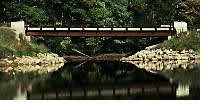Design of Short Span Steel Bridges
Frank Russo, Ph.D., PE,
Project Manager
URS Corporation
Philadelphia, PA
John C. Huang, Ph.D., PE,
Principal
CHC Engineering,
LLC
Herndon, VA
 Highway
bridges are vital links in the nationís transportation network. The Federal
Highway Administration estimates nearly one-third of America's 578,000 bridges
need to be repaired or replaced. The majority of these bridges are short-span,
linking vitally important state, county and municipal roads. The
structural advantages of using steel include its lighter weight, which means
lighter foundations and lower erection costs. Steel is ideal for short-span
bridges because of its durability, ease of maintenance and ease of construction.
Highway
bridges are vital links in the nationís transportation network. The Federal
Highway Administration estimates nearly one-third of America's 578,000 bridges
need to be repaired or replaced. The majority of these bridges are short-span,
linking vitally important state, county and municipal roads. The
structural advantages of using steel include its lighter weight, which means
lighter foundations and lower erection costs. Steel is ideal for short-span
bridges because of its durability, ease of maintenance and ease of construction.
Bridge engineering has continued to evolve as increasing knowledge of material
properties, structural behavior, and the environment under which they exist
change methods of design and construction. In this course, the basic principle
and theory of designing short span steel bridges based on AASHTO Load Factor
Design method are introduced. An example of steel bridge girder design utilizing
this LFD method is also presented.
The course materials were developed in accordance with the Strength Design Method
(Load Factor Design) of the AASHTO Standard Specifications for Highway Bridges
16th Edition, 1996, including the 1997, 1998, and 1999 Interim Specifications,
referred to herein as the AASHTO Specifications. The course is intended for
practice engineers and engineering students with basic knowledge of steel structures.
When designing a short span steel bridge, the following important aspects shall be taken into consideration:
- Safety
- Serviceability
- Constructibility
- Economy
- Aesthetics
In this course, the focus is on the design issues related to the safety, the serviceability and the constructibility The following summarizes some of the basic design items and design procedures for short span simple steel beam bridges:
- Calculating Loads
- Dead Loads (Non-Composite and Composite)
- Live Loads (AASHTO HS Truck and Lane Loading)
- Impact
- Determining Demands
- Factored Maximum Design Moment and Shear
- Overload Stress
- Live Load Deflection
- Fatigue Stress Range
- Calculating Section Properties
- Section Modules (Non-Composite, Long Term and Short Term)
- Plastic Neutral Axis (Force Equilibrium)
- Calculating Capacities
- Moment Capacity - Bending Strength (Considering Ductility and Web Slenderness for Composite Sections and Torsional and Local Buckling for Non-Composite Sections)
- Shear Capacity - Shear Strength (Considering Web Slenderness and Buckling)
- Determining Allowables
- Overload Allowable Stress
- Fatigue Allowable Stress
- Allowable Live Load Deflection
- Checking Safety
- Bending Strength v.s. Maximum Design Moment
- Shear Strength v.s. Maximum Design Shear
- Checking Serviceability
- Overload Stress v.s. Allowable (Permanent Deflection)
- Live Load Deflection v.s. Allowable (Service Load)
- Fatigue Stress Range v.s. Allowable (Critical Details)
- Checking Constructibility
- Web Local Buckling
- Lateral-Torsional Buckling
- Top Flange Local Buckling
- Beam Strength to Support Construction Loads
- Determining the Governing Limit State
- Demand/Capacity Ratio for Each Limit State
- The Largest Ratio Corresponds to the Governing Limit State
In
this lessen, you need to view the slide show Design
of Short Span Steel Bridges, which includes
basic design procedures and a practical example for short span bridge design. If you prefer to study the course content offline, you may download the course content from the following link:
Design of Short Span Steel Bridges (a PDF file, 3.7 MB)
Please click on the underlined hypertext above to view, download or print the document for your study. Because of the large file size, we recommend that you first save the file to your computer by right-clicking the mouse and choosing "Save Target As ...", and then open the file in Adobe Acrobat Reader.
QuizOnce you finish viewing the slide show, you need to take a quiz to obtain the PDH credits.
Additional Technical Resource and Further Readings:
1. American Association of State Highway and Transportation Officials, Manual for Condition Evaluation of Bridges, Washington, DC, 1994.
2. American Association of State Highway and Transportation Officials, Standard Specification for Highway Bridges, 1996, Edition, 1997,1998 and 1999 Interim Specifications - Bridges, Washington, DC.
3. American Association of State Highway and Transportation Officials, Guide for Painting Steel Structures, Washington, DC, 1997.
4. American Iron and Steel Institute, Integral Abutments for Steel Bridges, by Ed Wasserman, PE, and J. Houston Walker, PE, 1996. (Available from the National Steel Bridge Alliance, Chicago, IL).
5. Short Span Bridge Design Software - AISIBEAM V 3.0 / American Iron and Steel Institute (This software is no longer available from AISI).
6. Missouri Highway and Transportation Department. Task Force Report on Weathering Steel, January 1996.
7. Rubeiz, C.G., and Gorman, C.D., Pre-Engineered Short Span Steel Bridges, ASCE Structures Congress, Atlanta, GA, 1994.
8. Taavoni, S., Comprehensive Package for the Design of Short Span Steel Bridges, National Symposium on Steel Bridge Construction, Atlanta, GA, 1993.
9. AASHTO, Guide Specifications for Highway Bridge Fabrication with HPS70W Steel, Washington DC 2000.
***
Acknowledgment:
PDHonline.com acknowledges the sponsorship of American Iron and Steel Institute (AISI) for this online course.
***
![]()
DISCLAIMER:
The materials contained in the online course are not intended as a representation
or warranty on the part of PDHonline.com or any other person/organization
named herein. The materials are for general information only. They are not
a substitute for competent professional advice. Application of this information
to a specific project should be reviewed by a registered professional engineer.
Anyone making use of the information set forth herein does so at their own
risk and assumes any and all resulting liability arising therefrom.
![]()
